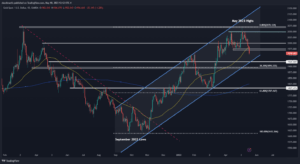Gold prices crumbled on Thursday, falling for a third consecutive session and reaching their lowest level since the beginning of April. In early afternoon trading in New York, XAU/USD was down 1.4% to $1,960, dragged down by U.S. dollar strength and rapidly rising bond yields following encouraging macro data and news that the U.S. Congress is making progress in negotiations to raise the debt ceiling.
The primary bearish drivers for the precious metal were the strength of the U.S. dollar and the rising U.S. yields. These factors put significant downward pressure on gold prices, signaling a challenging period for investors.
Focusing on today’s catalysts, unemployment claims corresponding to the previous week and the Philadelphia Fed’s manufacturing production for May were much less negative than anticipated. This reinforced the view that business activity remains remarkably resilient despite numerous headwinds such as tightening lending standards, sticky inflation, and non-stop recession talk in financial media.
With the economy holding up better than expected, the market is gradually pricing out the aggressive easing that had been discounted for the second half of 2023 in the immediate aftermath of the U.S. banking sector turmoil that erupted in March. Although with some qualms, it seems traders are starting to position for a “higher for longer” interest rate regime again, which poses a significant risk for precious metals.
The optimism over the prospect of an agreement to raise the U.S. borrowing cap and avoid a federal default also appeared to hurt safe-haven assets, including gold. Sentiment took a turn for the better after House Speaker Kevin McCarthy said that the lower chamber of Congress could vote on a deal as soon as next week, indicating progress in discussions.
Fundamentals of the Gold Market
While the fundamentals for gold remain somewhat constructive, the situation could change if the U.S. economy manages to stabilize and avoid a recession. In such a scenario, interest rates could remain elevated for longer than initially anticipated, undercutting non-yielding assets and boosting the U.S. dollar. It is crucial for traders to closely monitor incoming data in the weeks and months ahead to gauge the potential impact on gold prices.
Technical Outlook
In terms of technical analysis, gold prices broke below cluster support at $1,975, accelerating their retreat and reaching the weakest point in over a month on Thursday. Although the recent decline appears to be a corrective move within a medium-term uptrend, the outlook could turn negative if bears continue to exert pressure on the market.

In the event of a larger pullback, initial support is expected near $1,920, which represents the lower limit of a rising channel in play since September of the previous year. Bulls would ideally want to prevent prices from breaching this floor, as a breach could invite further selling pressure and a potential test of $1,895, the 38.2% Fibonacci retracement level of the September 2022 to May 2023 rally.
On the flip side, if bulls regain control of the price action and spark a rebound, technical resistance is likely to be encountered at $1,975, followed by the psychological level of $2,000.
As the market remains sensitive to economic developments and monetary policy signals, it is essential for traders and investors to stay vigilant and adapt their strategies accordingly in the dynamic gold market.
Further Gold Analysis…

